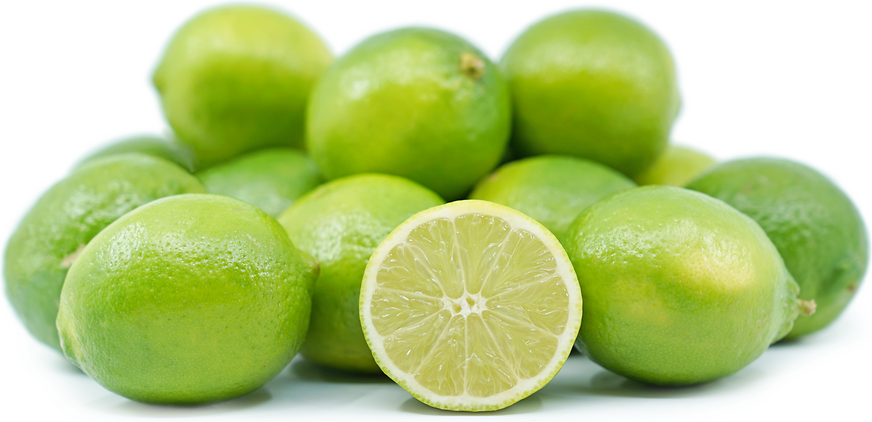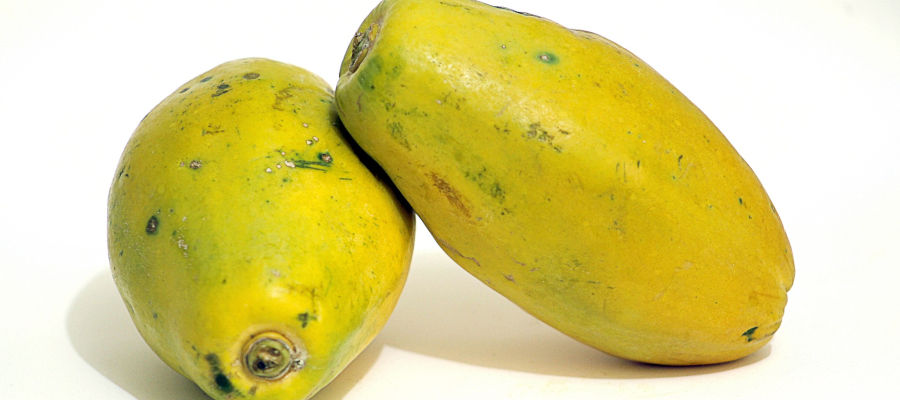Are there any health benefits of eating limes? We will get to that soon, but let's tell you more about limes first. Limes are a popular citrus fruit that is most commonly grown in tropical environments among the likes of oranges, grapefruits, and lemons. Because of their famous, citrusy, sharp, sour flavor, they are oftentimes used to flavor different foods and beverages with their unique taste. They are similar to other citrus fruits in more ways than just their flavor; limes are also packed full of Vitamin C, a powerful antioxidant that provides plenty of support to the immune system. Limes also possess digestive enzymes that make it easier for your body to break down your food.
What are Limes?
Limes are a citrus fruit that is commonly grown in tropical environments. They are round, green fruits that usually measure around three to six centimeters in diameter and are full of small juice vesicles that are acidic and sharp. Now that we know what they are, let's continue talking about the health benefits of eating limes.

Source: https://specialtyproduce.com/ - Limes
What do limes taste like?
Limes have a very sharp, tangy sour flavor that is instantly recognizable. They are quite bitter, but they fall somewhere in between refreshing lemons and sharp grapefruits in terms of bitterness with just a hint of sweetness.
Difference between lime and lemon?
Is there a difference in terms of the health benefits of eating limes when they are compared with lemons? In contrast to the yellow lemon fruit, the lime fruit is much smaller and green. Apart from these optical recognition features, the fruits also differ in taste and ingredients. The difference in taste is that green limes taste more intense and aromatic. This is why the lime is often used for cocktails, e.g. caipirinha, mojito or daiquiri. The lemon, on the other hand, is sourer than the lime.
How can you cook with limes?
Limes are commonly used around the world to flavor a variety of different foods and beverages because of their sharp, tangy flavor that can add brightness to any food. Limes can be used for their juice before a meal is served to offer a bright finishing touch and as a popular garnish, or they can be used with their juices mixed into food as it cooks. They are also a common choice for mixing into adult beverages, and some people like to spritz lime juice into their water to enhance its flavor and aid indigestion.
The vitamins and minerals of the lime
Health benefits of eating limes can also be found when it comes to vitamins and minerals. The lime is a fruit rich in vital substances that can contribute to health in many ways. Lime contains many minerals such as calcium, potassium, magnesium, and sodium. Lime also contains vitamin E, as well as many vitamins of the B group such as vitamin B5, which helps us to cope better with stress. In terms of meeting the recommended daily intake, however, vitamin C is of primary importance. 100 grams of lime juice contains about 43 milligrams of vitamin C, which is 30% of the officially recommended daily intake. Since vitamin C is an important antioxidant that intercepts and neutralizes free radicals in the blood, brain, and body cells, limes are a great way to protect against infections, especially in the winter months. Apart from the antioxidants already mentioned, limes also contain beta-carotene and a whole range of secondary plant substances with antioxidant effects, such as the so-called bioflavonoids.
The health benefits of eating limes don't stop here, we've got more. Bioflavonoids are mainly found in the lime peel. They increase the effectiveness of vitamin C. The bioflavonoid hesperidin is already being used successfully in medicine for venous leg complaints and hemorrhoids. Both bioflavonoids and carotenoids have a positive influence on high blood fat values, help to lower cholesterol, and thus effectively protect our blood vessels from calcification. They are therefore regarded as important protective factors against heart disease. As it is almost impossible to absorb sufficient bioflavonoids from limes, you can fall back on flavonoid-rich lime extract, which is available in the form of a dietary supplement. Since the lime peel also contains the health-promoting essential lime oil, you should always use the peel of untreated limes or use the essential lime oil when flavoring food and drinks.
The healing effects of a lime
Can the health benefits of eating limes also be considered as a remedy? The essential lime oil is obtained either by steam distillation of the ground fruits or by cold pressing the peels. About 150 kilograms of limes are needed to produce one liter of essential oil. It is used in the production of food and cosmetics as well as in medicine and consists of 85 percent monoterpenes (mainly limes). These are secondary plant substances with analgesic, warming, and anti-inflammatory properties. Monoterpenes have a positive effect on the autonomic nervous system, stimulate the immune system, and activate the body's defenses. But they also benefit the mind and soul, as they lift the mood, counteract anxiety, and promote concentration and logical thinking. Sesquiterpenes have similar properties. They contribute to skin health and have a regulating effect on the release of histamine in allergies. Another plant substance in the essential lime oil is citrate. It is responsible for the intensive, fresh scent of the lime, but also keeps viruses, bacteria, fungi, and - e.g. in the fragrance lamp or body oil - insects in check in a natural way.
Lime as a tropical remedy
There are also many other health benefits of eating limes. While the lemon has been an integral part of traditional medicine in Europe for thousands of years, the lime is practically uncharted territory for us. And yet it has long been known that lemons and limes have a similar composition of active ingredients due to their close relationship and thus have many things in common in terms of their healing properties. In subtropical and tropical countries, however, where the lime is even more important than the lemon, it has long been used as a remedy. The areas of application include, for example
-
Anti-Aging
-
Disinfection of drinking water
-
Strengthening of the immune system
-
colds, e.g. for sore throats, sinusitis, and fever
-
Depressive moods
-
Rheumatism
-
Malaria
In the meantime, numerous scientific studies have already confirmed that the lime can actually prevent and alleviate many diseases.
Uses of limes

Source: https://i.ytimg.com/
The health benefits of eating limes are incredible if you know how to add them to your dishes. Like its big sister the lemon, the lime also tastes sour but is also characterized by an exotic, slightly tart flavor. The fruit juice not only provides a lot of pep in alcoholic drinks but also in non-alcoholic cocktails and smoothies. In addition, lime juice is ideal for adding a fruity and sour note to delicious sauces, salad dressings, and soups. How about a delicious Asian coconut soup or a papaya-mango salad rich in vital substances? The grated lime peel is always in demand when the unmistakable citrus aroma needs to be highlighted. It adds the finishing touch to all more or less exotic dishes such as Mexican vegetable stews. The peel can also be used to refine desserts - e.g. lime cake, lime cream or lime tiramisu. In the lime countries, lime leaves cut into wafer-thin strips are also used. They provide a fine, fresh spice. On the Arabian Peninsula, on the other hand, the seasoning Loomi is used in rice dishes, for example. Ripe limes are boiled in salted water and then dried in the sun.
Are there any health benefits of eating limes?
Like other citrus fruits such as lemons, oranges, and grapefruits, limes are rich in vitamin C. Vitamin C is one of the most powerful antioxidants and is famously known to be able to support the immune system and ward off infections. By supporting the immune system, the body may also enjoy a healthier response to inflammation. The potent antioxidants may help to remove toxins from the body caused by free radicals, which often cause premature cellular aging. Because of this, the skin may show a reduction of signs of premature aging, such as fine lines and wrinkles.
Purchase, storage, and preparation of limes
As you already know, Persian lime is the main ingredient we offer. When buying it, make sure that the fruit has a light green, shiny skin, as a dark green color indicates an unpleasantly sour taste. Kaffir limes can be bought in well-assorted Asian shops. You should also make sure to use organic limes, especially if you want to use the skin. Limes can be stored in a cool room for up to 3 weeks. If they are stored at room temperature, they dry out more quickly than lemons and must therefore be consumed in about 5 days. Always wash your limes thoroughly under warm water before peeling or squeezing them and then rub them dry.
Lime as a honey mask
Lime juice is a proven household remedy that helps kill bacteria, remove dead skin cells, and close large pores. The following recipe is well suited to refine the skin texture in a natural way.
Ingredients:
-
1 tsp lime juice
-
1 tablespoon liquid honey
application:
-
Mix the ingredients and gently cream your face with it.
-
Leave the mask on over a steam bath or in the sauna for about 15 minutes.
-
Wash your face thoroughly with warm water.
In addition, essential lime oil offers many possibilities for cosmetic treatment.
Lime juice - An ayurvedic ritual
Health benefits of eating limes don't only appear when it is eaten as a fruit, try lime juice for a change. In Ayurveda, a glass of warm lime juice is drunk in the morning after getting up in order to reduce the disease-causing "ama" - as in Ayurveda, waste products are called. Because of the warm lime juice...
-
cleans and stimulates the liver by inhibiting the flow of bile.
-
promotes digestion, as it is similar to digestive juices in terms of its composition
-
helps the intestine to empty itself more easily in a natural way.
-
can lower blood pressure.
-
counteracts hyperacidity of the body by increasing the pH value. You can find further interesting information on the subject of hyperacidity and deacidification at
-
The secret of proper deacidification
Furthermore, lime juice can also be applied externally to do something good for the skin.
Stopping smoking with the help of lime juice
Anyone who has ever tried to quit smoking knows how difficult this can be. Various nicotine substitutes are used, but they also contain harmful nerve poison. Thai scientists from Srinakharinwirot University have shown that lime juice reduces the desire to smoke and is comparable to the effect of nicotine gum. The study involved 100 subjects, who were divided into two groups. One group resorted to nicotine chewing gum for 3 months to quit smoking, the other to freshly squeezed lime juice. The tests showed that the lime juice was almost as effective at curbing the desire to smoke as nicotine gum - and without any nicotine at all.
The lime extract acts against tuberculosis pathogens
In Guatemala, a wide variety of medicinal plants are used to combat bacteria and fungi. Researchers from Brigham Young University in Utah have examined a total of 141 plants. The study showed that the essential lime oil efficiently inhibits all the microbes studied - Staphylococcus aureus, Escherichia coli, Streptococcus mutans, Lactobacillus acidophilus, and Candida albicans - and can therefore be helpful in relation to the associated diseases. Tuberculosis is also transmitted by bacteria and - contrary to what is often assumed - leads the worldwide statistics of fatal infectious diseases. Mexican scientists from the Universidad Autónoma de Nuevo León have discovered that lime peel extract contains some active ingredients such as citral, which are effective against the most important pathogen of tuberculosis in humans (Mycobacterium tuberculosis).
Health benefits of eating limes in cancer research

Source: https://eatandbeatcancer.files.wordpress.com/
What are the possible health benefits of eating limes when it comes to cancer? Cancer researchers have also already looked into the lime and see great potential in cancer prevention and future therapies. Indonesian researchers from Universitas Gadjah Mada, for example, have discovered that various flavonoids in the lime peel have anticarcinogenic, tissue proliferation-inhibiting, and estrogenic effects. Lime peel extract can thus prevent cancer, stop the growth of tumor cells, and even drive them to death. The phytoestrogens contained in lime peel have an effect similar to that of the body's own estrogens and can alleviate climacteric complaints, but also naturally reduce the risk of osteoporosis and breast cancer. In contrast, a study at Texas A&M University has shown that lime juice can also prove helpful in this context. The scientists concluded that the flavonoids it contains have an antioxidant effect and can cause tumor cells to shrink and die.
Lime: A new cure for Alzheimer's?
What are the health benefits of eating limes when it comes to Alzheimer's desease? For the treatment of mild to moderate stages of Alzheimer's disease, conventional medicine recommends so-called acetylcholinesterase (AChE) inhibitors such as donepezil, as they can have a beneficial effect on the course of the disease. In Alzheimer's patients, nerve cells that "communicate" with each other using the messenger substance acetylcholine are poorly interconnected. They produce too little acetylcholine. With the help of AChE inhibitors, the signal exchange between the nerve cells can be improved. Several studies have already shown that lime extracts extracted from the peel and leaves and the essential lime oil have the same effect as the AChE inhibitors. Italian researchers from the University of Calabria agree that in this sense especially older people can benefit from the healing power of lime.
The Origin and Distribution of limes
Instead of only talking about the health benefits of eating limes, let's take a look at the fruit's origin. The green too - depending on the variety - yellow limes grow on a shrub or short-stemmed tree up to five meters high. Literally translated, the term "lime" means as much as "small lime". Limes and lemons are closely related, as are the other types of citrus. The lime is believed to originate mainly in India and on the Malay Peninsula. Citrus aurantiifolia, the Mexican lime or "bartender lime", is currently considered the most commonly cultivated citrus fruit in the tropics and subtropics. It is also sold in German supermarkets much more frequently than other lime varieties. In Southeast Asia, species that are quite unknown to us, such as kaffir lime or sweet citrus lametta, are also very widespread. If you want to know more about the health benefits of eating limes, stay tuned for our next blogs.


